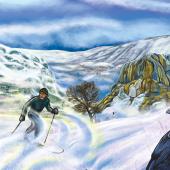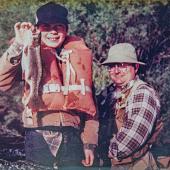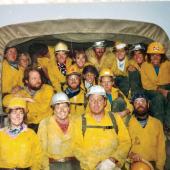Consider the Lilies
After a long winter in the Montana high country, glacier lilies are among the first color to return that does not crawl or creep or fly. In a sense they do move, though, their bright yellow blossoms flourishing in the bare earth and melting snow that ride ever higher up the mountain, until the last snow finally disappears. The cheerful little lilies follow that elegant black-and-white boundary, drinking thirstily from the steady drip of the vanishing snow. The brightest, freshest blossoms are always closest to the drip line, while below them lie the sun-faded tatters of yesterday, reduced to worn-out prayer-flag-looking remnants in only a week’s time. Generation after generation of lilies chases the departing snow like a brilliant yellow fire, one wave after another, up and over the highest ridge.
Each year my family and I gather glacier lilies for our Easter dinner. After the eggs have been hidden and found numerous times, both in the house and out in the woods, my wife, two daughters, and I take a walk up one of the south-facing slopes and forage among the lilies, as if partaking of the food of the resurrection. More than a handful can give you a stomachache, so we eat only a few and bring home a few—sweet and crisp—to place in our salad.
Grizzlies have been sleeping beneath these mini-glaciers, suspended like astronauts in the frozen earth. Soon they, too, will prowl these sun-fields just below the snow line, grazing on the delicious lilies. They also dig for roots, making them farmers of a kind, aerating the soil and thus nurturing one of the crops that first greet them upon resurrection each year. And on those same glistening ice shields that grow smaller each day, the grizzly mothers with their cubs slide down the slopes on their backs—cartwheeling into the fields of yellow, then climbing right back up to the top—sliding and playing for hours at a time. As the lilies follow the snow and the bears follow the lilies, the script of life begins moving with reckless style once again.
What to make of such sights? Each evening before I go back to writing, I let my girls jump off the porch headlong into my arms—a six step leap. In midair their faces are always, always purely radiant. I do not want their hearts to be strangers to the wild flights of joy. But I want them also to know restraint, discipline, and economy (my weaknesses, so they are not likely to get them through my shared blood). They love to pick wildflowers but they have to learn not to pull the whole plant up by the roots. They have to learn about sensitivity and rarity. Trilliums don’t do well in a vase, so we don’t pick them. And even though a magnificent orchid, the purple-and-gold fairy slipper, is abundant in this northern forest, it is much diminished elsewhere, and so each girl takes only one per year. (Later in the full vegetative roar of summer, they will be able to pick other flowers to their hearts’ content: double fistfuls of sweet-scented royal blue lupine, huge bouquets of fire-red paintbrush, cerise fireweed, pearly everlasting, and oxeye daisies. They gather yarrow, too, to dry and save for treating the sore throats of February and March, steeped in a hot tea.)
I try to teach gratitude and respect. I remind the girls that the glacier lilies are the season’s first food for the 15-20 grizzlies we have left in this valley, and I counsel them that we are visitors to this mountaintop, and our own needs are usually excessive, rarely as primal as those of the other forest dwellers. I can’t use that language, of course. I just tell them to take only one or two blossoms from each clump and to leave far more than they take. To eat some on the mountaintop and save some for our evening’s dinner of elk steak (sometimes from that same mountain) and garden potatoes.
I believe firmly in the sanctity of the seasons; in the regularity of cycles; in the bedrock foundations of loving ritual, celebrating feasts, and thanks-giving. I can’t use that language, either. I don’t have the words to explain these things to them yet. Instead, on our hike out, I show them the big footprints where the bears have been walking and playing and sliding in the snow.












